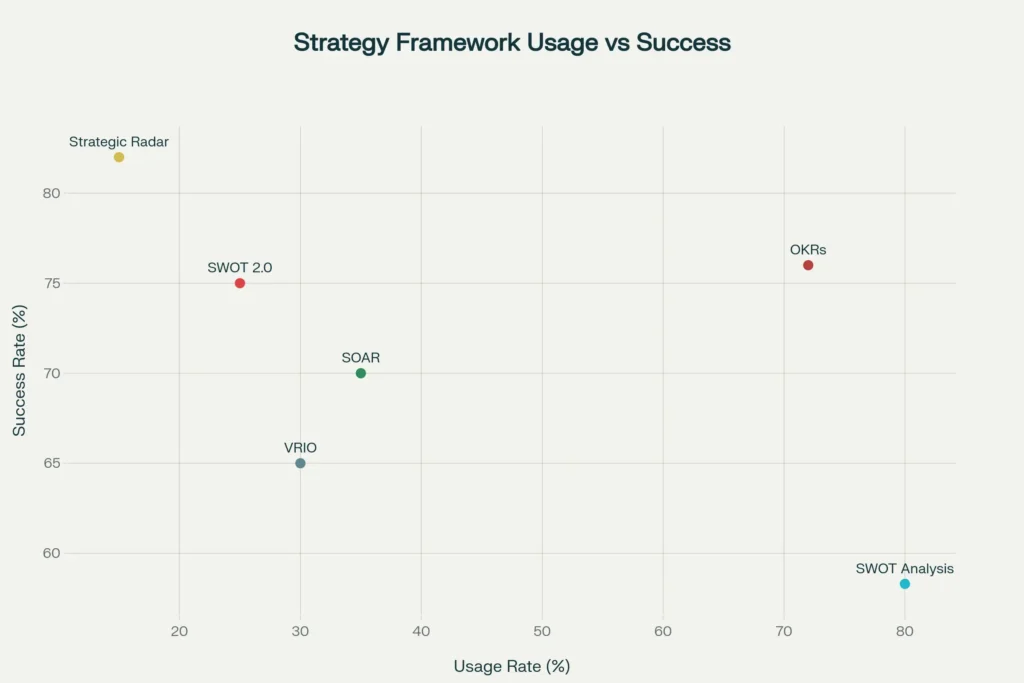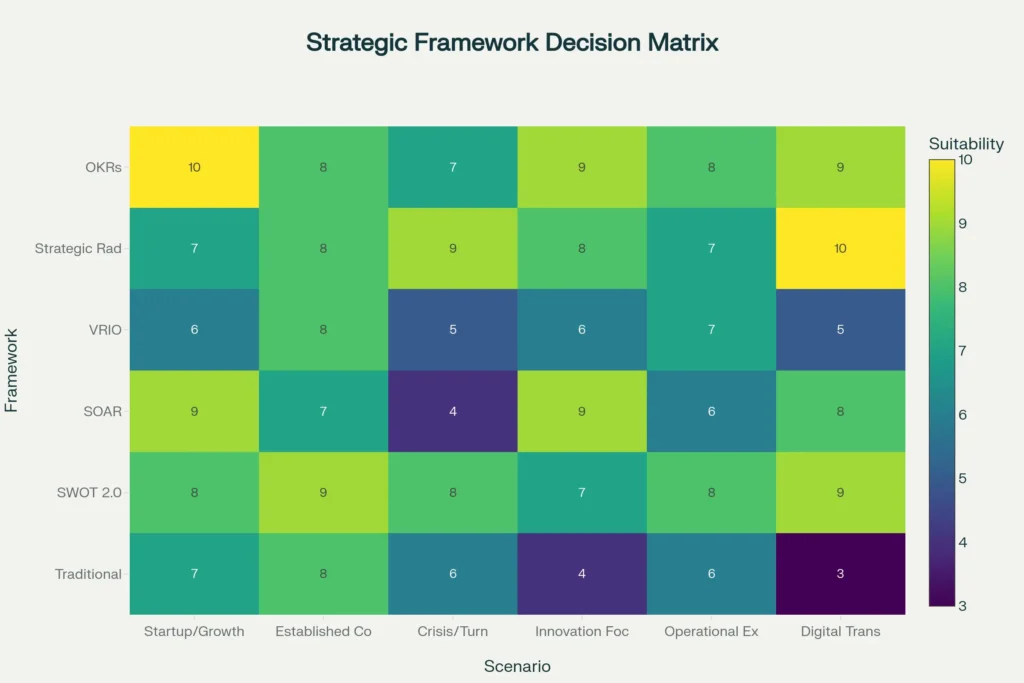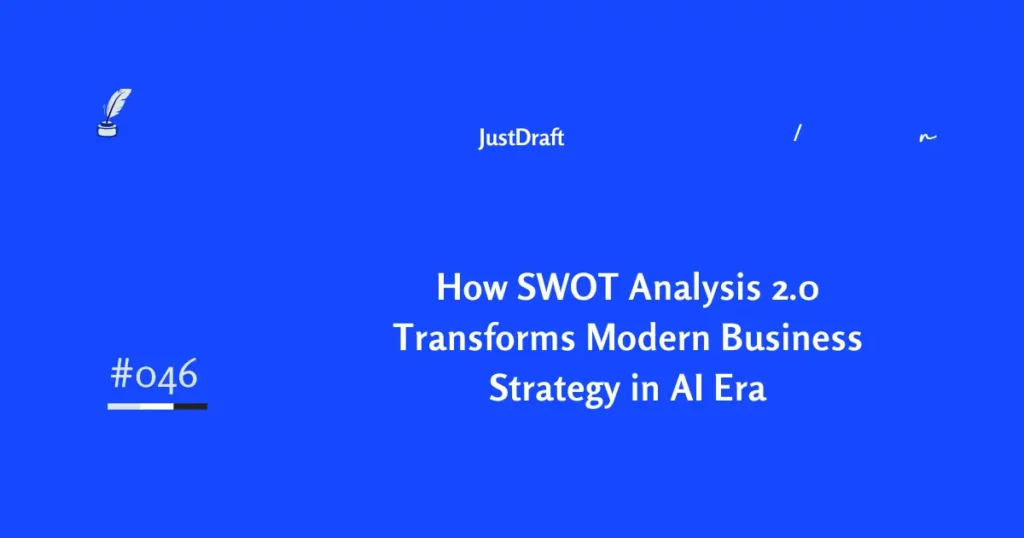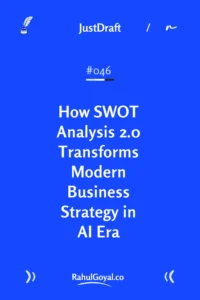How SWOT 2.0 Analysis Transforms Modern Business Strategy
Picture this: Twelve senior executives, expensive consultant, fancy hotel conference room. Someone draws the famous four boxes on a whiteboard. For three hours, they fill those boxes with gems like “our people are our biggest asset” and “economic uncertainty is a threat.”
The result? A beautiful 47-slide PowerPoint deck that nobody opened again.
Three months later, a nimble startup with five employees and a laptop ate their lunch in the market they thought they owned.
If this sounds familiar, you’re not alone. And you’re definitely not crazy for feeling frustrated with traditional strategic planning.
One Topic: SWOT 2.0 in AI Era
The Uncomfortable Truth About SWOT
Here’s what nobody wants to admit: Traditional SWOT analysis is killing more strategies than it’s creating.
The numbers are brutal. While 80% of companies still use classic SWOT for strategic planning, only 58% consider their planning sessions successful. That’s a coin flip success rate for something you’re betting your company’s future on.
Meanwhile, companies that have moved beyond traditional SWOT are reporting 87% improvement in strategy execution. The gap isn’t closing – it’s getting wider every quarter.
But here’s the thing that really gets me: SWOT itself isn’t the enemy. It’s how we’re using it that’s broken.
What’s Really Going Wrong in Your Planning Room
The brutal reality? 83% of strategies fail not because of bad analysis, but because of terrible execution planning.
You’re creating lists, not strategies. “Strong brand reputation” tells you nothing about what to do Monday morning. It’s like saying “we have a car” when what you need is directions to your destination.
Everything gets equal weight. A minor HR process issue gets the same attention as Amazon entering your market. That’s like treating a paper cut and a heart attack with the same urgency.
You’re planning in slow motion. While you’re analyzing last quarter’s data, your competitors are already executing next quarter’s strategy. By the time you finish planning, the world has changed.
Nobody owns the outcomes. Classic SWOT sessions end with insights, not assignments. Beautiful analysis, zero accountability.
How Smart Companies Are Fixing Strategic Planning
The companies winning in today’s market aren’t abandoning strategic analysis – they’re doing it smarter.
Here’s what SWOT 2.0 actually looks like:
Replace opinions with data. Instead of “good customer service,” track Net Promoter Score, response times, and resolution rates. Numbers don’t lie or get emotional.
Make it live, not static. Your strategic framework should update continuously, not annually. When metrics change, strategies should change too.
Connect analysis to action. Every insight needs an owner, a deadline, and a measurement system. If it doesn’t lead to action, it’s just expensive brainstorming.
Include everyone, not just executives. The people closest to customers and operations often have the most valuable strategic insights.

The Frameworks That Are Actually Working
Smart leaders aren’t stuck on one approach. They choose the right tool for the right situation:
Use SOAR when you need to energise your team. Strengths, Opportunities, Aspirations, Results. Success rate: 70%. Perfect when morale is low and you need people excited about possibilities, not worried about problems.
Use VRIO for competitive advantage. Valuable, Rare, Inimitable, Organised. Success rate: 65%. Great when you need to figure out what truly makes you different and defensible in the market.
Use Strategic Radar in crisis mode. Success rate: 82% – the highest of any framework. When everything is changing fast and you need dynamic sensing of threats and opportunities.
Use OKRs for execution focus. Objectives and Key Results. Success rate: 76%. The sweet spot when you know what to do but need better execution and accountability.

The Secret: Layer Your Approaches
The most sophisticated companies don’t pick one framework and stick with it forever. They combine approaches strategically.
Start with upgraded SWOT for comprehensive analysis. Apply TOWS Matrix to convert insights into specific strategic options. Use VRIO to validate your competitive advantages. Execute with OKRs for quarterly accountability.
Companies using integrated strategic approaches report 63% more confidence in their long-term direction and 45% faster decision-making.
Three Steps to Fix Your Strategic Planning
- Audit your last session honestly. If you produced more than 15 action items with unclear owners or no deadlines, you need a new approach.
- Test one upgrade for 90 days. Pick SWOT 2.0 or SOAR for one business unit. Measure the difference in actionable outcomes and team engagement.
- Connect everything to real numbers. Whatever framework you choose, link it to live data and automatic progress tracking. Strategy without measurement is just expensive wishful thinking.
The Bottom Line
Your competitors aren’t using better strategies – they’re using better strategic planning tools.
The old model of annual planning retreats that produce static documents is dying. The future belongs to dynamic, data-driven strategic frameworks that adapt in real-time and actually drive results.
Here’s the hard truth: While you’re still filling out four boxes once a year, your competition is planning faster, executing better, and moving ahead.
The question isn’t whether traditional SWOT needs an upgrade. The question is how much market share you’re willing to lose while you figure that out.
What’s your biggest frustration with strategic planning right now? Hit reply and tell me – I read every response and your challenges often inspire future newsletters.

Read last week’s LensLetter newsletter about Hasselblad’s New Camera X2D II.
Interested in travel, Read last week’s JustDraft about Blue Sky Thinking vs Constraint-Based Innovation.
Two Quotes to Inspire
Leaders who confuse brainstorming with planning risk running in circles with sharper pencils.
The strength of strategy isn’t in the plan—it’s in how fast you adjust when the plan meets reality.
One Passage From My Bookshelf
The most basic idea of strategy is the application of strength against weakness. The most common path to this basic strategic insight is not a deep theory but simply noticing a difference. The difference may be an imbalance between the size of opposing forces, the technology they use, the morale or training of their people, or the resources they can bring to bear. These differences are the raw material of strategy. A good strategy does more than urge us forward toward a goal or vision; it acknowledges the challenges and provides a coherent approach to overcoming them. The kernel of a good strategy contains a diagnosis of the situation, a guiding policy, and coherent action.
📚 From Good Strategy Bad Strategy by Richard Rumelt

